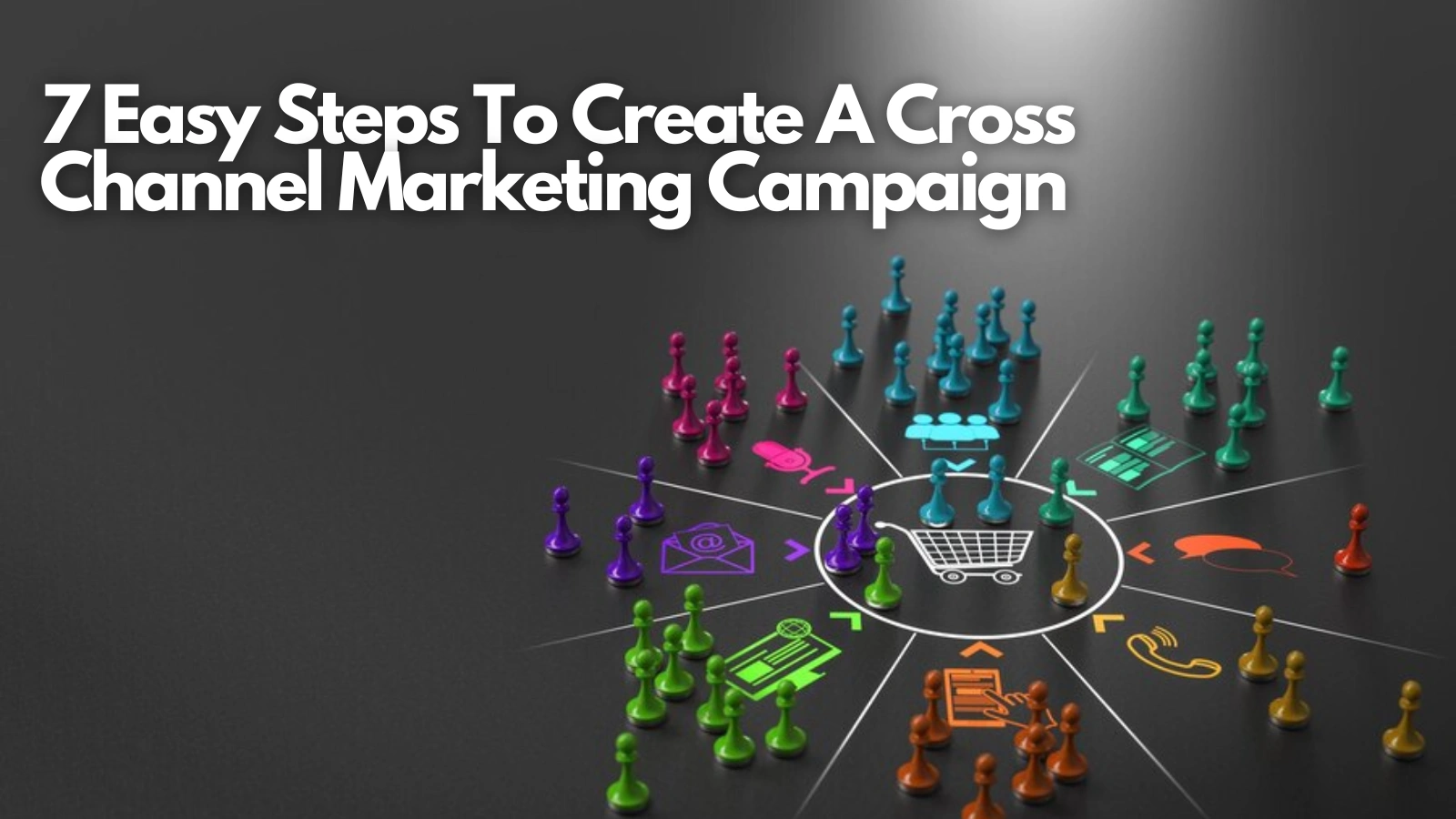7 Easy Steps To Create Cross Channel Marketing Campaigns
Just imagine running a business where every customer magically finds you, engages and buys—all in one place. Sounds like a dream, right? But in reality, customers are everywhere. If you rely on just one platform, you’re missing out.
That’s where cross channel marketing campaigns come in. They let you connect with your audience across multiple platforms—social media, email, search ads, and more. The result? More engagement, better conversions, and a smoother customer journey.
But let’s be real—cross channel campaign management isn’t just about showing up on different platforms. It’s about delivering the right message, at the right time, in the right place. And if done wrong, it can feel messy and disconnected.
The good news? You don’t need a huge budget or a big team to make it work. With the right strategy, you can create seamless cross channel marketing campaigns that attract, convert, and keep customers coming back.
Follow these 7 easy steps to build a campaign that works across channels and drives real results!
Hit ‘Play’ Button & Tune Into The Blog!
What Is Cross Channel Marketing Campaigns?
Cross channel marketing campaigns are a strategy that connects different marketing platforms to create a smooth and engaging customer experience. Instead of relying on a single channel, businesses use multiple touchpoints—social media, email, search ads, websites, and even offline methods—to reach and engage customers effectively.
The goal? To ensure every interaction feels connected, no matter where the customer engages with your brand. When done right, cross channel marketing campaigns keep your audience engaged, improve conversions, and create a consistent brand experience across all platforms.
Why Do Cross Channel Marketing Campaigns Matter?
cross channel marketing campaigns ensure that every interaction feels connected, guiding customers seamlessly from one step to the next. It’s not just about being everywhere—it’s about delivering the right message at the right time and creating a smooth and engaging experience. Here’s why it matters:
Better Customer Experience
People interact with brands across multiple platforms daily. A disconnected experience can confuse or frustrate them. A cross channel marketing campaigns ensures that whether they see your ad on social media, visit your website, or get an email, the message stays consistent and relevant.
Increased Engagement & Conversions
Customers don’t always buy on the first interaction. They might need reminders and touchpoints along their journey. When your marketing efforts work together, engagement increases, leading to higher conversions. Studies show that customers interacting with brands on multiple channels tend to buy more often.
Stronger Brand Presence
A consistent message across different platforms helps build trust. Big brands like Apple and Nike don’t rely on just one channel. They use ads, emails, physical stores, and social media to reinforce their identity. Cross-channel campaign management ensures your brand stays recognizable and impactful.
Are There Any Challenges In Cross Channel Marketing Campaigns?
Running cross channel marketing campaigns sounds great—until you face the challenges. Managing multiple platforms, tracking customer interactions, and ensuring a seamless experience isn’t easy. Here are the biggest hurdles marketers face:
1. Reaching Audiences at the Right Time
With so many platforms, it’s tough to know where and when to connect with your audience. User behavior changes, and what works for one channel might not work for another. A well-planned cross channel marketing campaigns needs precise timing and strategy to make an impact.
2. Managing Data for Better Insights
Good data drives great campaigns. However many businesses struggle with messy or incomplete data. Without high-quality insights, it’s hard to personalize marketing efforts. And with the move toward a cookieless future, brands need to rethink how they collect and use customer data.
3. Choosing the Right Advertising Channels
Not all platforms work for every audience. Finding the best channel for your cross channel marketing campaigns requires a deep understanding of customer behavior. Whether social media, email, or TV ads, each channel plays a different role in the customer journey.
4. Marketing Attribution Issues
Tracking results across multiple platforms is tricky. Many brands rely on click-through rates but miss the bigger picture. For example, someone might see an ad but buy later through another channel. Cross channel marketing campaign examples show that using a mix of analytics tools can give a clearer picture of what’s driving results.
Despite these challenges, smart strategies and the right tools can help marketers create effective cross channel marketing campaigns that boost engagement and conversions.
Read More:
All You Need To Know About Advertising Insights + Examples
7 Easy Steps To Create A Cross Channel Marketing Campaign
Successful cross channel marketing campaigns ensure smooth customer experiences, no matter where they engage with your brand. From social media and emails to websites and offline channels, every touchpoint should be consistent and connected. Here’s a simple 7-step process to build a winning cross channel marketing campaigns that drives engagement and conversions.
Step 1: Gather and Unify Your Data
Accurate data is the foundation of any successful campaign. Before launching cross channel marketing campaigns, ensure you have a complete picture of your customers. Collect data from your website, social media, emails, and offline interactions. Use tools like CRM software, analytics platforms, and automation tools to centralize this information.
A unified view helps you understand customer behavior and create personalized marketing strategies. Without clean and organized data, your campaign might miss the mark.
Step 2: Segment Your Audience
Not all customers are the same. That’s why audience segmentation is crucial in cross-channel campaign management. Divide your customers into groups based on:
- Demographics – Age, gender, location
- Behavior – Purchase history, browsing habits
- Engagement – Email open rates, social media activity
Once segmented, tailor your messages to suit each group’s needs and preferences. This increases engagement and improves your campaign’s effectiveness.
Step 3: Choose The Best Channels
Your customers are spread across different platforms, but not all channels will be equally effective. Identify where your audience spends most of their time and focus on those. Some common channels for cross channel marketing campaigns include:
- Social Media – Facebook, Instagram, LinkedIn
- Email Marketing – Personalized email campaigns
- Website & Blog – SEO-driven content and web push notifications
- SMS & Push Notifications – Instant engagement on mobile
- Offline Marketing – Billboards, flyers, and in-store promotions
A good cross-channel campaign management strategy ensures every platform works together seamlessly.
Step 4: Build Micro Funnels
Before going big, start small. Micro funnels help test different aspects of your campaign. For example, if your goal is to reduce cart abandonment, create a campaign that targets users who left items in their cart.
- Send a reminder email
- Follow up with a push notification
- Offer a discount through SMS
By focusing on micro funnels, you can optimize smaller parts of your campaign before scaling them up.
Step 5: Test & Optimize Campaigns
No campaign is perfect from the start. Testing helps you refine your strategy and improve performance. Use A/B testing and multivariate testing to find out:
- Which subject lines work best in emails
- What type of content drives the most engagement
- The best time to send notifications or messages
Analyze results and adjust your campaign accordingly. This step is essential for effective cross-channel campaign management.
Step 6: Scale What Works
Once you identify winning strategies, it’s time to scale up. Expand your campaign to a larger audience while maintaining personalization. Cross-channel marketing campaigns should evolve based on customer behavior and market trends.
Automation tools can help manage large-scale campaigns efficiently. These tools allow you to:
- Repurpose successful campaigns for new audiences
- Automate follow-ups and reminders
- Personalize content for different segments
Scaling the right way ensures your campaign continues to deliver results.
Step 7: Track, Analyze, and Improve
A great cross-channel marketing campaign doesn’t end after launch. Regular monitoring helps you understand what’s working and what needs improvement. Use analytics tools like Google Analytics, social media insights, and email reports to track:
- Engagement rates
- Conversion rates
- Customer journey insights
If something isn’t performing well, tweak your strategy and test new ideas. The key to successful cross channel marketing campaigns is continuous learning and improvement.
But why stop analyzing your campaigns when you can learn from your competitors? This is where PowerAdSpy comes in. It’s a powerful ad spy tool that helps you uncover competitor strategies, analyze top-performing ads, and refine your cross-channel campaign management. With access to a vast ad library, you can see what’s working in your industry and craft winning campaigns of your own.
Let’s have a detailed look at this mind-blowing tool!
PowerAdSpy: AI-Based Ad Intelligence Software
PowerAdSpy is an advanced AI-powered ad intelligence tool that provides deep insights into competitors’ advertising strategies. It is a comprehensive ad intelligence tool that covers 10+ social media platforms including Facebook, Instagram, YouTube, LinkedIn, Google, Pinterest, Reddit, and Quora. This ads spy tool is invaluable for businesses seeking to refine their ad approaches and develop effective campaigns.
PowerAdSpy offers a range of essential features for enhancing ad engagements:
- Extensive Ad Library: Access a vast collection of millions of ads from over 100 countries. Users can easily explore competitors’ ads and identify successful campaigns with just a few clicks.
- Ad Search: Find ads by using keywords, advertiser names, domains, or other criteria. This feature helps users locate relevant ads within their niche or industry.
- Ad Analytics: Gain comprehensive insights into ad performance, including engagement metrics such as likes, shares, and comments, along with detailed demographic data on target audiences.
- Targeting Insights: Discover the targeting options used in ads, including demographics, interests, behaviors, and placements, to enhance your targeting strategies.
- Ad Creatives: View various ad creatives, including images, videos, and copy, to analyze competitors’ messaging and design techniques.
- Bookmarking: Save and organize valuable advertising insights and audience profiles with a single click. Bookmarking ads and their details aids in strategic planning and ad development.
With these features, PowerAdSpy empowers users to craft high-performing ads by leveraging detailed competitor insights and optimizing their ad strategies.
6 Tips for Building a Successful Cross-Channel Marketing Campaign
Creating a successful cross-channel marketing campaign requires a strategic approach to reach and engage your target audience across various touchpoints. Here are six tips from a marketing perspective to optimize your campaign’s effectiveness:
1. Define Clear Leadership & Roles
To ensure your cross-channel marketing campaigns are well-coordinated, designate a leader responsible for overseeing the entire campaign. A senior-level role dedicated to cross-channel campaign management ensures consistency across all channels, driving better results and seamless execution.
2. Implement A Unified Measurement Strategy
A comprehensive measurement approach gives you a clear picture of how each channel impacts the customer journey. By tracking the interaction between channels, you can determine what’s driving conversions and allocate your budget more effectively, reducing wastage.
3. Develop Customer Personas for Precision
Effective cross-channel marketing campaigns depend on knowing your audience inside and out. Use both aggregate and person-level data to create detailed customer personas. This enables you to craft tailored messages and content that resonate with different audience segments, improving engagement and conversion rates.
4. Continuously Optimize KPIs
It’s essential to track and optimize key performance indicators (KPIs) to gauge the effectiveness of your cross channel marketing campaigns. Analyzing past campaign performance, including cross channel marketing campaign examples, allows you to refine your strategies and improve ROI over time.
5. Choose the Right Marketing Tools
The right technology stack can make or break your campaign. Leverage marketing automation tools to optimize ad placements, personalize messaging, and track real-time campaign performance. This helps ensure your ads are reaching the right audience at the right time, across all platforms.
6. Base Decisions on Data-Driven Insights
Successful marketing is all about data. Collect insights from all touchpoints, including customer behavior and engagement across platforms. Use this data to refine your messaging and optimize your cross channel marketing campaigns for maximum impact.
By implementing these strategies and learning from cross-channel marketing campaign examples, marketers can enhance their campaigns and deliver a more personalized, seamless experience that drives results.
Conclusion
Cross channel marketing campaigns are the key to reaching and engaging your audience wherever they are. By leveraging the right strategies and tools, you can create campaigns that drive higher engagement and conversions. Check out cross-channel marketing campaign examples to see what works best.
With PowerAdSpy, you can get a competitive edge by analyzing your competitors’ ads and refining your strategies. Ready to boost your campaign performance? Let PowerAdSpy help you craft winning strategies that resonate across every platform!
Frequently Asked Questions
How do I know which channels are right for my campaign?
It depends on where your target audience spends their time. Consider your customers’ behaviors, preferences, and demographic data to identify which platforms are the most effective for reaching them—whether it’s Facebook, Instagram, email, or other channels.
How do I personalize my messaging across multiple channels?
Personalization involves using data insights to tailor your messages to specific segments of your audience. Use CRM tools and audience segmentation to customize your content based on demographics, behavior, and engagement, ensuring that every touchpoint is relevant.
How do I use competitor insights in my cross channel marketing campaigns?
With tools like PowerAdSpy, you can analyze competitor ads and strategies to see what’s working in your industry. By learning from successful cross-channel marketing campaign examples, you can refine your approach, optimize your ad creatives, and improve your targeting.










